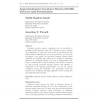Free Online Productivity Tools
i2Speak
i2Symbol
i2OCR
iTex2Img
iWeb2Print
iWeb2Shot
i2Type
iPdf2Split
iPdf2Merge
i2Bopomofo
i2Arabic
i2Style
i2Image
i2PDF
iLatex2Rtf
Sci2ools
IDEAL
2010
Springer
2010
Springer
Approximating the Covariance Matrix of GMMs with Low-Rank Perturbations
: Covariance matrices capture correlations that are invaluable in modeling real-life datasets. Using all d2 elements of the covariance (in d dimensions) is costly and could result in over-fitting; and the simple diagonal approximation can be over-restrictive. In this work, we present a new model, the Low-Rank Gaussian Mixture Model (LRGMM), for modeling data which can be extended to identifying partitions or overlapping clusters. The curse of dimensionality that arises in calculating the covariance matrices of the GMM is countered by using low-rank perturbed diagonal matrices. The efficiency is comparable to the diagonal approximation, yet one can capture correlations among the dimensions. Our experiments reveal the LRGMM to be an efficient and highly applicable tool for working with large high-dimensional datasets.
Covariance Matrices | Diagonal Approximation | IDEAL 2010 | Intelligent Agents | Simple Diagonal Approximation |
| Added | 04 Mar 2011 |
| Updated | 04 Mar 2011 |
| Type | Journal |
| Year | 2010 |
| Where | IDEAL |
| Authors | Malik Magdon-Ismail, Jonathan T. Purnell |
Comments (0)

